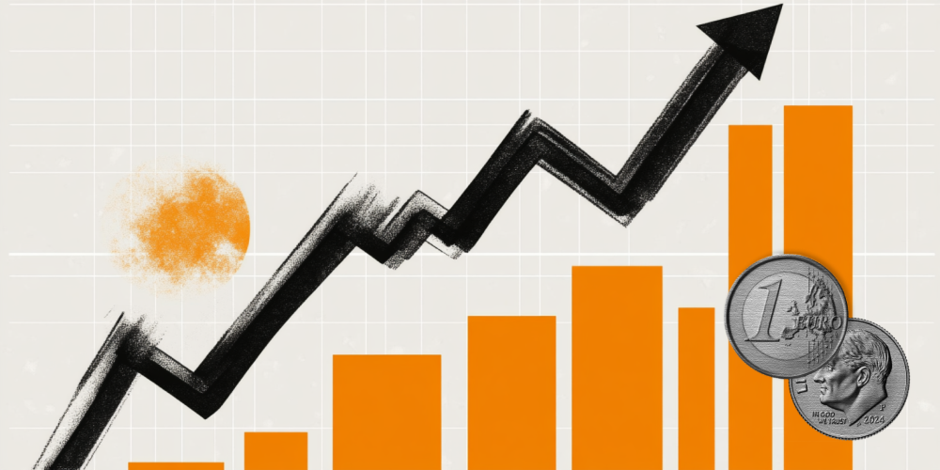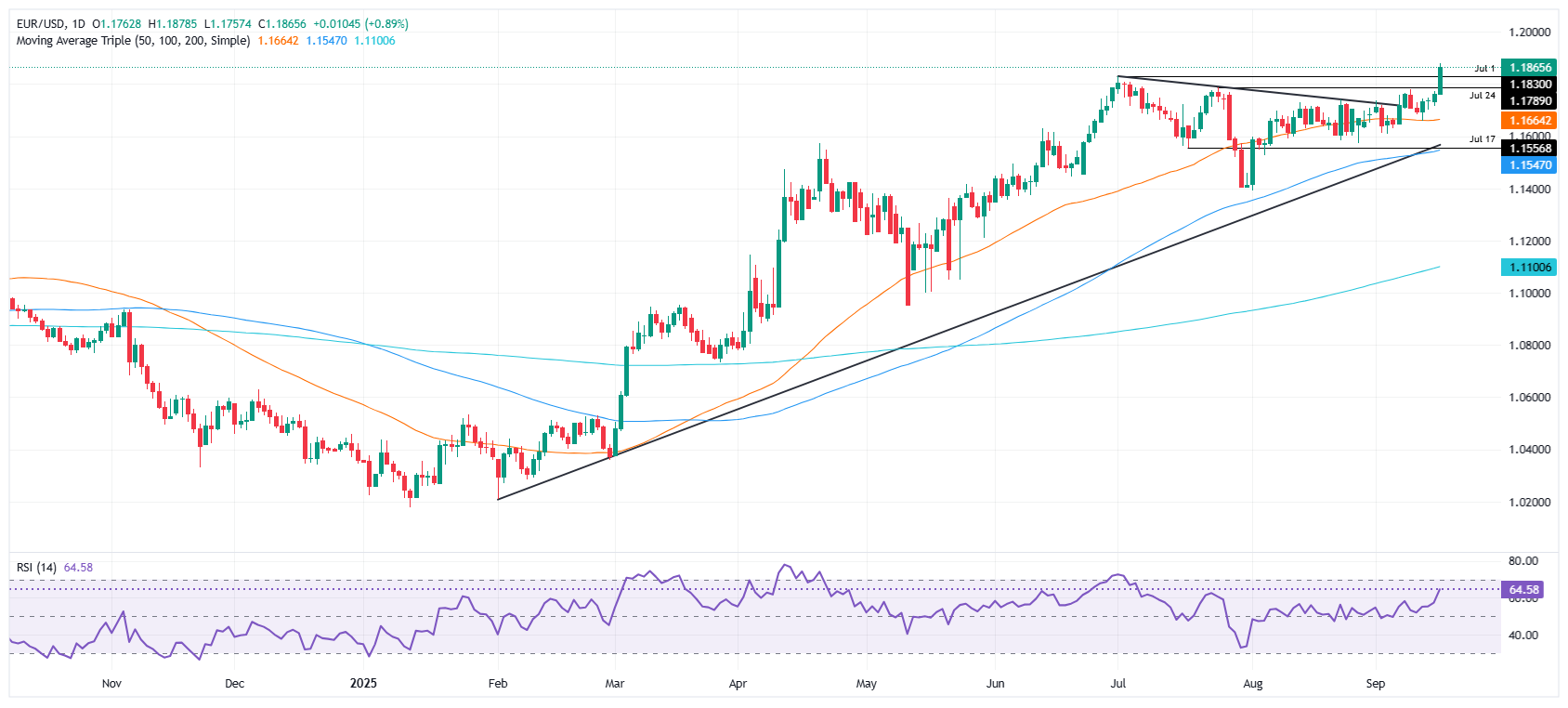Created
: 2025.09.16














![]() 2025.09.17 07:33
2025.09.17 07:33
The EUR/USD rallied to a four-year high of 1.1878 on Tuesday as investors ditched the Dollar on increased bets that the Federal Reserve will resume its easing cycle this week. The pair trades at 1.1865, up almost 0.90% at the time of writing.
The US Dollar remains pressured as market participants await the Fed's decision and the Fed Chair Jerome Powell's press conference. Traders ignored goodish Retail Sales and Industrial Production prints in the United States (US) and drove the EUR/USD more than 100 pips to its highest level since 2021.
The Fed meeting that started on Tuesday will be the first for Dr. Stephen Miran, nominated by US President Donald Trump. Additionally, Fed Governor Lisa Cook would also attend after the US Court of Appeals denied the White House's request to block her from attending the meeting.
Traders anticipated a rate cut in September and two additional cuts for the remainder of the year. Market participants should monitor the upcoming press conference by Fed Chair Powell and the "dot plot," which allows officials to outline their projections for future interest rates.
Across the pond, the ZEW Economic Sentiment survey in Germany showed that investors' expectations are growing optimistic, despite the languishing performance of the economy. Meanwhile, Industrial Production in the Euro Area improved, but trailed estimates.
Up next in the docket, EUR/USD traders will eye the release of Inflation figures in the Eurozone.
The table below shows the percentage change of Euro (EUR) against listed major currencies this week. Euro was the strongest against the US Dollar.
| USD | EUR | GBP | JPY | CAD | AUD | NZD | CHF | |
|---|---|---|---|---|---|---|---|---|
| USD | -1.11% | -0.70% | -0.81% | -0.69% | -0.61% | -0.61% | -1.29% | |
| EUR | 1.11% | 0.44% | 0.24% | 0.43% | 0.55% | 0.46% | -0.19% | |
| GBP | 0.70% | -0.44% | -0.12% | -0.02% | 0.10% | 0.01% | -0.74% | |
| JPY | 0.81% | -0.24% | 0.12% | 0.09% | 0.25% | 0.18% | -0.48% | |
| CAD | 0.69% | -0.43% | 0.02% | -0.09% | 0.19% | 0.03% | -0.72% | |
| AUD | 0.61% | -0.55% | -0.10% | -0.25% | -0.19% | -0.09% | -0.76% | |
| NZD | 0.61% | -0.46% | -0.01% | -0.18% | -0.03% | 0.09% | -0.75% | |
| CHF | 1.29% | 0.19% | 0.74% | 0.48% | 0.72% | 0.76% | 0.75% |
The heat map shows percentage changes of major currencies against each other. The base currency is picked from the left column, while the quote currency is picked from the top row. For example, if you pick the Euro from the left column and move along the horizontal line to the US Dollar, the percentage change displayed in the box will represent EUR (base)/USD (quote).
EUR/USD uptrend extended on Tuesday, with traders poised to challenge the 1.1900 figure. Momentum remains bullish as depicted by the Relative Strength Index (RSI), which favors further upside as it remains shy of reaching overbought conditions.
If EUR/USD rises above 1.1900, the next key resistance levels would be 1.1950 and 1.2000. Conversely, a drop below 1.1850 exposes the previous yearly high of 1.1829 and 1.1800. On further weakness, the next support would be 1.1750 and the 20-day SMA at 1.1704.

The Euro is the currency for the 19 European Union countries that belong to the Eurozone. It is the second most heavily traded currency in the world behind the US Dollar. In 2022, it accounted for 31% of all foreign exchange transactions, with an average daily turnover of over $2.2 trillion a day. EUR/USD is the most heavily traded currency pair in the world, accounting for an estimated 30% off all transactions, followed by EUR/JPY (4%), EUR/GBP (3%) and EUR/AUD (2%).
The European Central Bank (ECB) in Frankfurt, Germany, is the reserve bank for the Eurozone. The ECB sets interest rates and manages monetary policy. The ECB's primary mandate is to maintain price stability, which means either controlling inflation or stimulating growth. Its primary tool is the raising or lowering of interest rates. Relatively high interest rates - or the expectation of higher rates - will usually benefit the Euro and vice versa. The ECB Governing Council makes monetary policy decisions at meetings held eight times a year. Decisions are made by heads of the Eurozone national banks and six permanent members, including the President of the ECB, Christine Lagarde.
Eurozone inflation data, measured by the Harmonized Index of Consumer Prices (HICP), is an important econometric for the Euro. If inflation rises more than expected, especially if above the ECB's 2% target, it obliges the ECB to raise interest rates to bring it back under control. Relatively high interest rates compared to its counterparts will usually benefit the Euro, as it makes the region more attractive as a place for global investors to park their money.
Data releases gauge the health of the economy and can impact on the Euro. Indicators such as GDP, Manufacturing and Services PMIs, employment, and consumer sentiment surveys can all influence the direction of the single currency. A strong economy is good for the Euro. Not only does it attract more foreign investment but it may encourage the ECB to put up interest rates, which will directly strengthen the Euro. Otherwise, if economic data is weak, the Euro is likely to fall. Economic data for the four largest economies in the euro area (Germany, France, Italy and Spain) are especially significant, as they account for 75% of the Eurozone's economy.
Another significant data release for the Euro is the Trade Balance. This indicator measures the difference between what a country earns from its exports and what it spends on imports over a given period. If a country produces highly sought after exports then its currency will gain in value purely from the extra demand created from foreign buyers seeking to purchase these goods. Therefore, a positive net Trade Balance strengthens a currency and vice versa for a negative balance.
![]()
Created
: 2025.09.16
![]()
Last updated
: 2025.09.17

FXStreet is a forex information website, delivering market analysis and news articles 24/7.
It features a number of articles contributed by well-known analysts, in addition to the ones by its editorial team.
Founded in 2000 by Francesc Riverola, a Spanish economist, it has grown to become a world-renowned information website.
We hope you find this article useful. Any comments or suggestions will be greatly appreciated.
We are also looking for writers with extensive experience in forex and crypto to join us.
please contact us at [email protected].
Disclaimer:
All information and content provided on this website is provided for informational purposes only and is not intended to solicit any investment. Although all efforts are made in order to ensure that the information is correct, no guarantee is provided for the accuracy of any content on this website. Any decision made shall be the responsibility of the investor and Myforex does not take any responsibility whatsoever regarding the use of any information provided herein.
The content provided on this website belongs to Myforex and, where stated, the relevant licensors. All rights are reserved by Myforex and the relevant licensors, and no content of this website, whether in full or in part, shall be copied or displayed elsewhere without the explicit written permission of the relevant copyright holder. If you wish to use any part of the content provided on this website, please ensure that you contact Myforex.
Myforex uses cookies to improve the convenience and functionality of this website. This website may include cookies not only by us but also by third parties (advertisers, log analysts, etc.) for the purpose of tracking the activities of users. Cookie policy